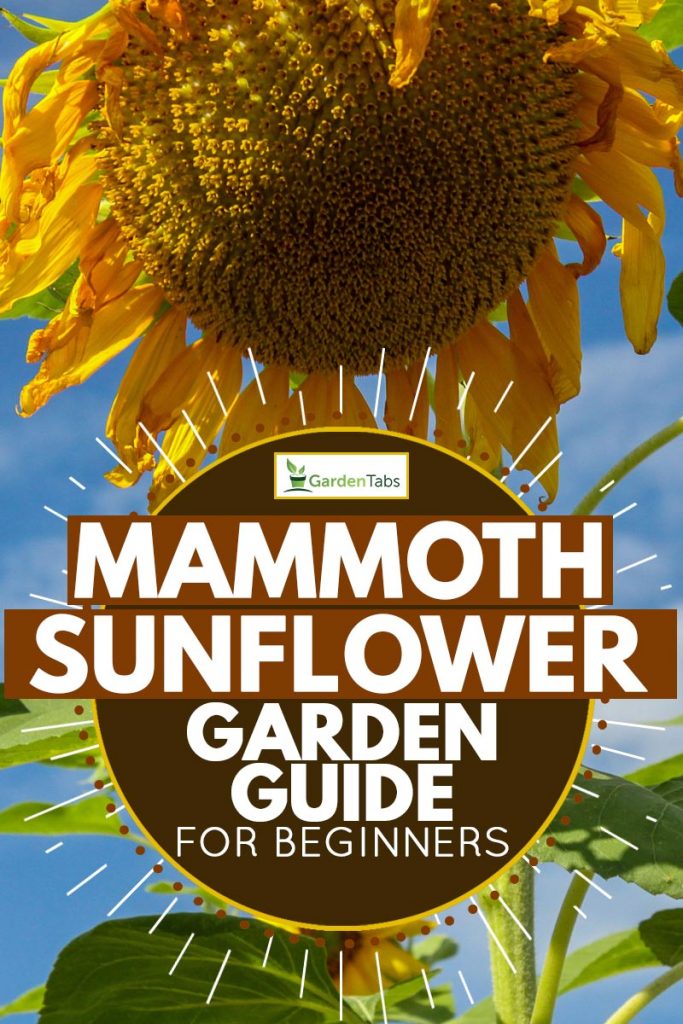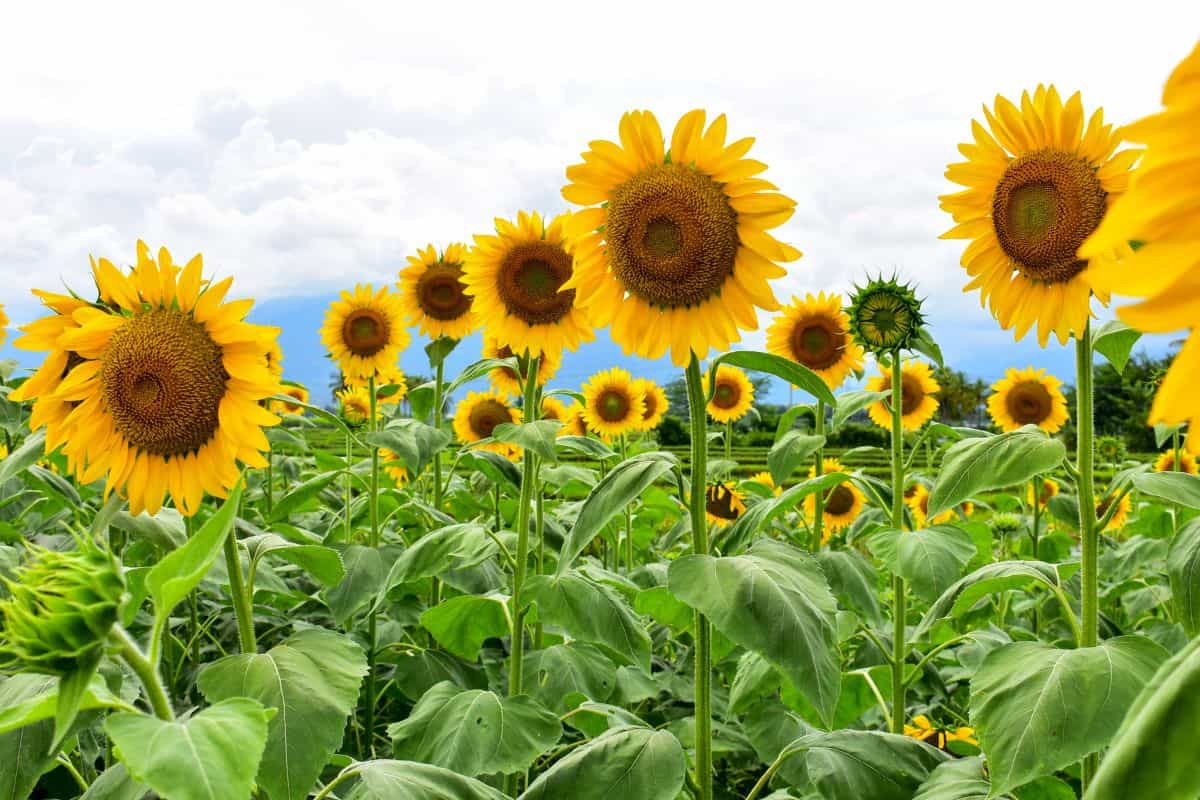Among numerous sunflower (helianthus annuus) varieties, the ginormous Mammoth is a delight. Not only is it easy to grow, but the sheer size of this radiant flower towering overhead strikes awe into onlookers below. Keep reading, and we will share with you how to best care for the mammoth sunflower to enjoy tremendous results in your garden or landscape.

What is the Mammoth Sunflower?
Mammoth or Russian Mammoth is a tall variety, single stem sunflower that was developed in Russia during the 18th century. It was historically cultivated for oil, producing a higher oil yield than other sunflower varieties. Today’s mammoth sunflower seeds have been hybridized mainly for agricultural purposes, to meet increasing worldwide demand for sunflower oil.

Both Mammoth grey stripe and Russian mammoth varieties produce similarity sized plants with lovely, ornamental flowers and edible seeds. Sturdy, bright green stems of mammoth sunflowers grow to heights between 9-feet and 12-feet tall. Broad, heart-shaped leaves adorn the stems. Massive, 20-inch flower heads atop have a daisy-like, cheerful disposition with bright yellow petals encircling a brown center.
How to Grow Mammoth Sunflowers?
Mammoth sunflowers are annual plants typically sown from seed that flourish outdoors in USDA Plant Hardiness Zones 2 - 11. Stimulate optimal growth by providing ideal growing conditions:
Soil

Sunflowers are not fussy about soil type, as long as it is not too compact for the taproot to penetrate easily. Mammoth sunflower taproots can grow down as far as 4-feet deep. Loamy to sandy, well-draining soils are most accommodating.
Mammoth sunflowers are happy with a soil pH of 6.0 to 7.5.
Sunlight
As you may have guessed, mammoth sunflowers do prefer full sun. Locate these flowers where they will receive six to eight hours of direct sunlight daily.
Water
Water regularly. Provide several gallons of water per week, by watering deeply to quench the taproot.
Fertilizer
Mammoth sunflowers demand nutrients because they are fast-growing plants. For best results, treat the soil with composted manure, or either slow-releasing granular or diluted liquid fertilizer.
Extra Support
Because they are so large and somewhat top-heavy, mammoth sunflowers might need the additional support provided by staking the stem.
Mammoth sunflowers are susceptible to wind damage, so try to locate these plants in an area where they will be sheltered from the wind, such as alongside a fence, wall, or natural windbreak.
Planting Step-by-step

Plant mammoth sunflowers during late spring, after the first frost, has occurred, and the soil temperature reaches 50 degrees Fahrenheit or warmer. To maximize flowering throughout the season, you can plant sunflowers in succession typically throughout May and mid-July.
- Water the soil.
- Sow each seed by pressing 1-inch deep with the pointed end facing downward and cover lightly with soil.
- Within 5 to 10 days, you should see seedlings emerge.
Ideal spacing for mammoth sunflowers is 20-inches apart; planted in rows 30-inches apart. For best results, you might want to sow multiple seeds in a cluster (each 6-inches apart) and thin the seedlings as they grow. By thinning the seedlings, you can select the hardiest sunflowers. Begin thinning seedlings at 3-inches, then again at 1-foot, and finally 2-feet tall.
Harvesting Sunflower Seeds

Either raw or roasted, sunflower seeds make a delicious, healthy snack. You can also preserve the seeds for next year’s planting, or use dried seeds as bird feed. When the flower head wilts and the foliage turns yellow, the sunflower is ready for harvest.
- Cover the flower head with cheesecloth to allow it to dry on the stem. The cheesecloth will protect the seeds from hungry birds, squirrels, mice, and deer and catch any loosely falling seeds as they dry.
- Cut the dried flower head from the stem.
OR
- Cut the wilted flower head from the sunflower’s stem.
- Either lie the head on a clean, dry surface or hang to dry in a location where it will be protected from hungry birds, squirrels, mice, and deer.
- Collect seeds into a bowl by rubbing your hand roughly over the center of the flower head. You can also use a fork to loosen seeds.
- Rinse the seeds and spread onto a clean, flat surface to dry.
- Store dried seeds in an air-tight container.
Wondering if you can grow sunflowers in a container? You can! Find out how by reading our blog, “Can You Grow Sunflowers in a Pot?”
Sunflower Photo Gallery
Gentle Giants
Mammoth sunflowers prefer to grow in a location that is protected from the wind. They make a lovely backdrop to hide a fence or wall.
Sneak Peek
Depending on the variety, fast-growing sunflowers will bloom between 80 and 120 days after sowing seeds. Enjoy these brilliant flowers all summer long by planting sunflowers in succession.
Sun Worshippers
Sunflowers are heliotropic, meaning they turn their flower heads to follow the sun. Scientists believe this circadian rhythm helps young stems to grow strong, to support heavy-laden mature flower heads.
Sunny Smile (Sunspot)
If you want that classic, mammoth sunflower look without the tremendous size, try the sunny smile variety. Although miniature (6” - 20” tall), this sunflower boats big beauty with yellow petals and a bold brown center.
Attract Wildlife
Sunflowers attract wildlife to your backyard. Butterflies and bees are attracted to the flowers’ pollen. Birds, squirrels, deer, and rabbits also like to munch on these tasty plants.
https://www.instagram.com/p/CBiyYnmBboL/?igshid=10a30hwiv4nuf
Record-breaking Dimensions
Mammoth sunflowers produce a massive head ranging from 15-inches to 20-inches in diameter. Just imagine the flower size of German gardener, Hans-Peter Shiffer’s world record, tallest sunflower grown at 30-feet, 1-inch tall.
Sprouting Seeds
Mammoth sunflower seeds sprout within 5 to 10 days after planting. It is best to plant seeds directly into the ground but to give sunflowers a head start for short growing seasons, you can start seedlings indoors.
https://www.instagram.com/p/B_uw3HiJImG/?igshid=l3wr4bo2vlgp
Photo Opportunity
Here we see a picture-perfect field of blooming sunflowers, an excellent backdrop for a family photo. Sunflowers are grown agriculturally, predominantly across the mid-west, as a rotation crop to help keep precious nutrients in the soil.
Branching Beauties
Branching sunflower varieties produce several blooms during the growing season. Because various colors and sizes are available, branching varieties make a lovely choice for growing bouquet flowers.
Child’s Garden
Capture children’s interest in gardening by planting mammoth sunflowers. Children will marvel at the sunflower’s ability to outgrow them by mid-summer, a great incentive to care for growing plants.
Gorgeous Shade-cover
Towering sunflower varieties like sunzilla, titan, and skyscraper can grow between 12-feet and 16-feet tall. Here we see tall variety sunflowers shading a comfortable sitting area.
Geometric Design
Developing seeds at the center of sunflowers intricately twist into tight-knit, spiraled, and circular patterns.
Striped Seeds
Variegated seeds of mammoth sunflower varieties are black and white striped. The striking appearance looks too pretty to eat!
Wilting Flowers
Wilting sunflowers are nearly ready to harvest. Wait for the petals to drop and foliage to yellow before cutting mammoth flower heads.
Complimentary Landscaping
Brilliant color and ginormous height not only make the sunflower a focal point, but here we see how the blooms complement the trim on this house to coordinate home and garden gracefully.
Where to Buy Mammoth Sunflowers Online?
Shop online to have mammoth sunflower seeds shipped directly to your door, and you will be ready for planting this spring.
Burpee
You will have a 100% satisfaction guaranteed when you purchase mammoth sunflower seeds from Burpee; 150 heirloom seeds per packet.
Click here to order from Burpee.
Amazon
Grow mammoth grey stripe sunflowers from David’s Garden Seeds available on Amazon; package of 50 heirloom seeds.
Click here to find this on Amazon.
Plant Sow Right Seeds to enjoy Russian mammoth sunflowers in your backyard; available on Amazon, 8-gram packet of heirloom seeds.
Click here to find this on Amazon.
Walmart
Mammoth grey stripe sunflower seeds from Mountain Valley Seed Company grow to enormous heights, available at Walmart, 8-gram packet of heirloom seeds.
Click here to find this at Walmart.
Now that you know how to care for mammoth sunflowers, you can order your seeds, and while you’re waiting, check out our blog, “What’s the Best Time to Plant Sunflowers?” for even more details about planting sunflowers.


